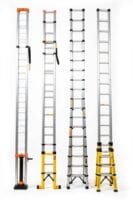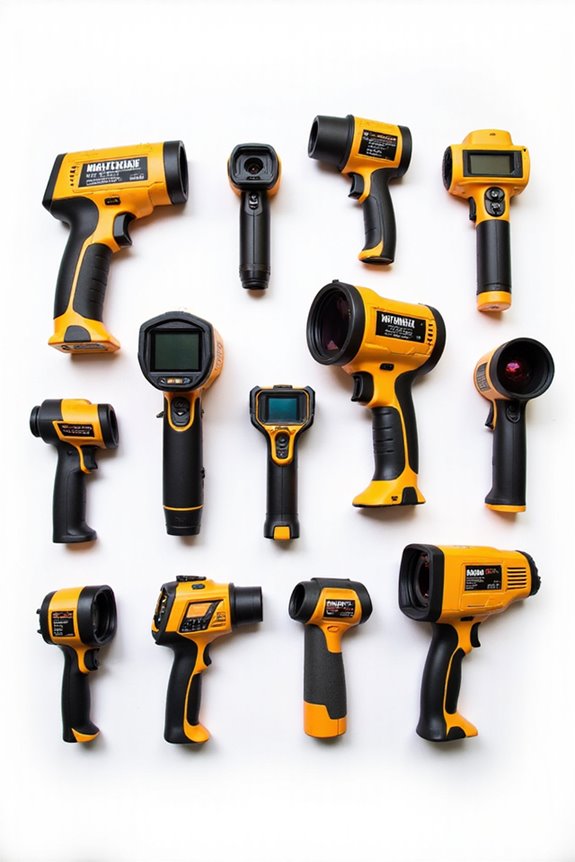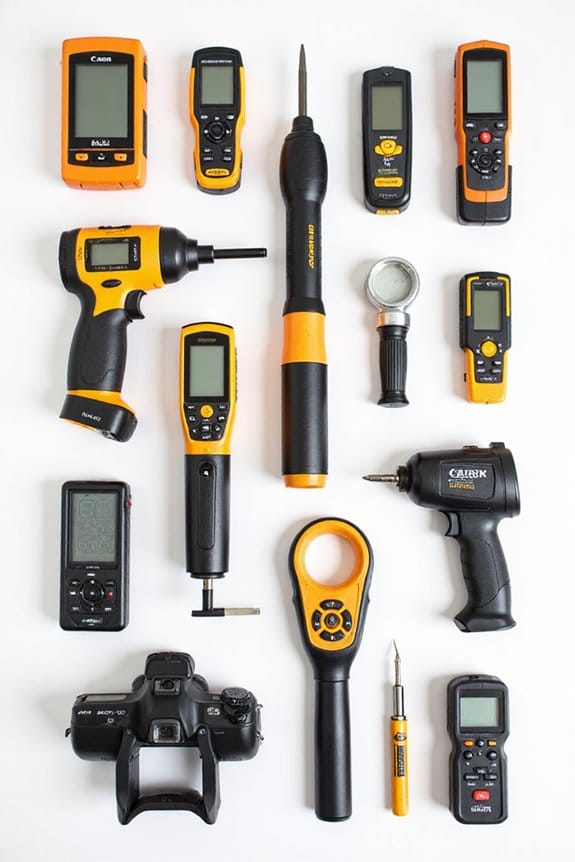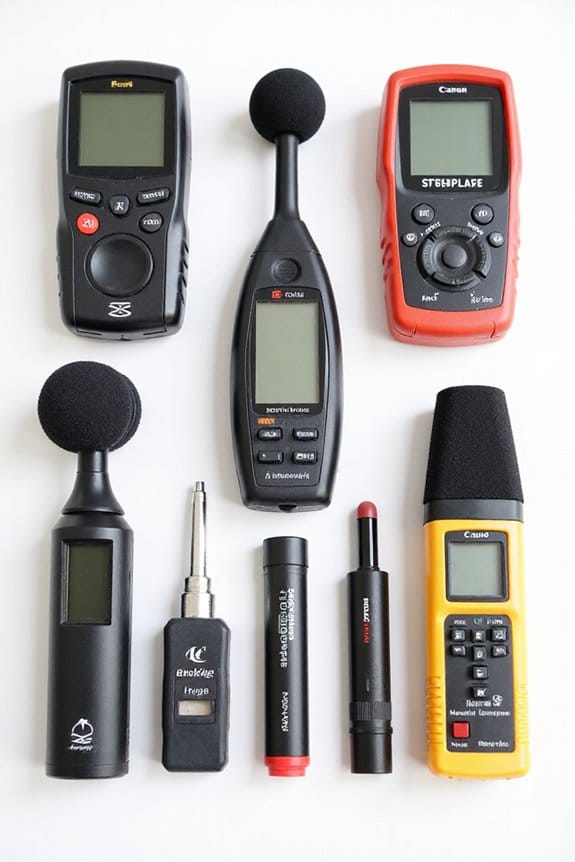As an Amazon Associate, we earn from qualifying purchases. Some links may be affiliate links at no extra cost to you. Although our opinions are based on curated research, we haven't used these products. Articles generated with AI.
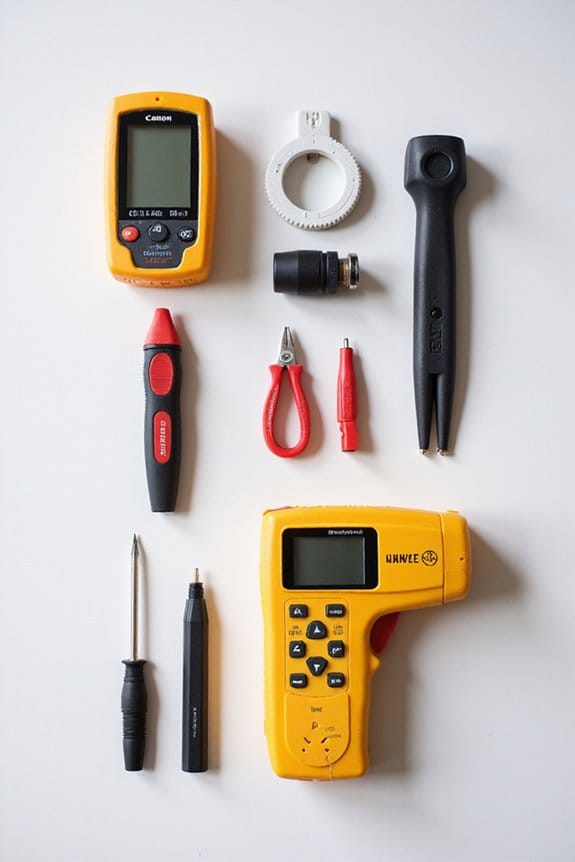
7 Best GFCI Testers of 2025 – Ensuring Safety With Every Use
If you’re looking for the best GFCI testers of 2025, you’ve got some great options! Check out the Klein Tools ET310KIT for fast breaker identification or the Sperry Instruments VD7504GFI for a durable, non-contact solution. The Gardner Bender GFI-3501 is perfect for identifying wiring issues, while the Outlet Tester (HT107B) is user-friendly with an LCD screen. Don’t forget the Klein Tools two-piece kit for thorough testing. Stick around, and you’ll discover more insights on selecting the right tool for your needs!
Key Takeaways
- Klein Tools ET310KIT is ideal for DIY enthusiasts, featuring a built-in GFCI tester and easy-to-read signals for quick circuit identification.
- Sperry Instruments VD7504GFI DualCheck combines non-contact voltage detection and GFCI analysis, perfect for both professionals and DIYers.
- Gardner Bender GFI-3501 offers reliable outlet testing with safety features, making it a favorite among electricians for identifying wiring issues.
- Outlet Tester HT107B provides visual feedback through an LCD screen, allowing for efficient diagnosis of six common wiring issues.
- Klein Tools Outlet Tester Kit is user-friendly and suitable for all levels, ensuring home safety and effective electrical troubleshooting.
Klein Tools ET310KIT AC Circuit Breaker Finder Kit
Klein Tools ET310KIT AC Circuit Breaker Finder Kit, Electric Tester, GFCI Tester, Leads, Adapters...
- ACCURATE CIRCUIT BREAKER IDENTIFICATION: Quickly locate the correct breaker with precision using the transmitter and receiver of the circuit breaker finder, ensuring...
- CLEAR INDICATIONS: The Receiver provides visual and audible cues when the correct breaker is found, ensuring a hassle-free locating process on 90-120V AC circuits
- BUILT-IN GFCI TESTER: The Transmitter includes a GFCI outlet tester, enabling you to inspect wiring conditions and test GFCI devices for added safety
If you’re a DIY enthusiast or a homeowner who frequently tackles electrical projects, the Klein Tools ET310KIT AC Circuit Breaker Finder Kit could be your new best friend. Here’s why you’ll love it:
- Accuracy: Quickly identifies the correct breaker using the transmitter and receiver. No more guessing!
- Clear Indications: Enjoy visual and audible signals when you find your breaker. It’s like a treasure hunt—only for circuits!
- GFCI Tester: Built-in tester checks GFCI devices, helping guarantee your home’s safety.
- Convenience: Comes with helpful adapters and a durable carry case. All set for your next project!
Get ready for smoother troubleshooting!
Best For: DIY enthusiasts and homeowners looking for an efficient solution to identify and troubleshoot circuit breakers.
Pros:
- Accurate detection of circuit breakers with clear visual and audible signals.
- Includes versatile adapters for various testing scenarios, enhancing usability.
- Durable carry case for organized storage and easy transportation.
Cons:
- Some users reported issues with the included battery, necessitating replacements.
- May require additional learning for those unfamiliar with electrical systems.
- Limited to 90-120V AC circuits, which may not cover all user needs.
Sperry Instruments VD7504GFI DualCheck Non-Contact Voltage Detector and GFCI Outlet Circuit Analyzer
Sperry Instruments VD7504GFI DualCheck 2-in-1 Non-Contact Voltage Detector + GFCI Outlet Circuit...
- SAVE TIME AND MONEY: With 2 popular testers in 1 unit - featuring a non-contact voltage detector on one end and GFCI outlet tester on the other
- DURABLE: Hi-Impact Resistant Polycarbonate Housing with soft over-molded rubber grips with a compact ergonomic design
- INDUSTRY LEADING: Advanced ground testing circuitry precisely detects the required low resistance values
The Sperry Instruments VD7504GFI DualCheck Non-Contact Voltage Detector is an excellent choice for DIY enthusiasts and professional electricians alike. This handy tool combines a non-contact voltage detector and a GFCI outlet analyzer in one sleek device.
Here’s why you’ll love it:
- Safe & Sensitive: Detects 50-600V AC without touching wires.
- Visual & Audible Alerts: Green means go; red means oh no!
- Durable Design: It’s tough enough to survive a 10 ft drop.
While some users report occasional false readings, its ease of use and reliability make it a must-have in your toolbox. Don’t miss out!
Best For: DIY enthusiasts and professional electricians looking for a reliable tool for quick electrical testing.
Pros:
- Versatile functionality: Combines a non-contact voltage detector and GFCI outlet analyzer in one device.
- User-friendly design: Simple green and red indicators make it easy to understand the status of electrical outlets quickly.
- Durable construction: Built to withstand drops and crushes, ensuring long-lasting performance.
Cons:
- False readings: Some users have experienced occasional inaccurate voltage detection.
- Durability concerns: The ground pin may become loose with repeated use, affecting reliability.
- Short lifespan with heavy use: Average longevity reported is 4-6 months, particularly for frequent users.
Gardner Bender GFI-3501 Ground Fault Receptacle Tester & Circuit Analyzer
Gardner Bender GFI-3501 Ground Fault Receptacle Tester & Circuit Analyzer, 110-125V AC, for GFCI /...
- Tests: standard outlets, GFCI outlets, extension cords
- Compact and easy to use
- Tester trips between 6-9 mA
For electricians and DIY enthusiasts alike, the Gardner Bender GFI-3501 Ground Fault Receptacle Tester & Circuit Analyzer stands out as a top choice. With a compact design and weighing just 0.05 pounds, it’s incredibly portable. This tester offers seven LED indicators to make your life easier. Here’s what it can do:
- Tests various outlets – Standard, GFCI, and extension cords.
- Identifies wiring issues – Open ground, hot/ground reverse, and more.
- Safety-focused – Trips GFCI for accurate testing.
User ratings of 4.6 stars highlight its reliability. Just remember, while testing is fun, staying safe is serious business!
Best For: Electricians and DIY enthusiasts looking for a reliable and portable tool to test and analyze electrical outlets.
Pros:
- Compact and lightweight design for easy portability.
- Offers comprehensive testing with seven LED indicators for quick diagnostics.
- Effectively trips GFCI for accurate ground fault testing, ensuring safety.
Cons:
- Some users may find it difficult to read the color codes on the LED indicators.
- Limited to testing within the 110-125V AC range, which may not suit all applications.
- Warranty details may vary, requiring verification for extended coverage.
Outlet Tester Electrical GFCI Receptacle Detector (HT107B)
YEREADW Outlet Tester Electrical GFCI Receptacle Detector, 90-250V Ground Fault Receptacle Tester &...
- Precision Outlet Tester: Ensure Wiring Safety with Ease. This outlet tester is the ideal tool for verifying the wiring of standard 3-wire and RCD-protected outlets...
- Clear LCD Feedback: The vibrant LCD display shows immediate results, with a green screen confirming correct wiring and an orange one highlighting faults. It also provides...
- Effortless and User-Friendly: Designed for convenience, this plug tester is incredibly simple to use. With a straightforward plug-and-play setup, anyone can use...
Searching for a reliable outlet tester that simplifies GFCI functionality? The Outlet Tester Electrical GFCI Receptacle Detector (HT107B) could be just what you need! Here’s why:
- User-Friendly: Its plug-and-play design means you won’t need an engineering degree.
- Clear Display: The LCD screen gives immediate results—green means go, and orange highlights problems.
- Quick Diagnosis: It handles up to six common wiring issues in a snap.
- GFCI Testing: One-touch testing guarantees you’re protected, but be careful—testing without GFCI might trip your system.
With its reliable functionality, you can confidently tackle electrical safety checks!
Best For: The Outlet Tester Electrical GFCI Receptacle Detector (HT107B) is best for professionals and DIY enthusiasts looking for a reliable and easy-to-use tool for electrical safety checks.
Pros:
- Clear LCD screen provides immediate visual feedback on wiring status.
- Simple plug-and-play setup makes it accessible for users of all experience levels.
- One-touch GFCI testing enhances safety confirmation with minimal effort.
Cons:
- May trip systems when testing outlets without GFCI protection.
- Limited to diagnosing only six common wiring issues, which may not cover all scenarios.
- Requires proper wiring conditions with currents above 30mA for accurate reading.
Klein Tools Outlet Tester Kit with GFCI Tester and Voltage Test Pen (2-Piece)
Klein Tools 80025 Outlet Tester Kit with GFCI Tester and Non-Contact Voltage Test Pen, 2-Piece
- SMART BUY: A complete, high-performance kit that offers convenience and value
- COMPLETE OUTLET TESTER TOOL KIT: Includes GFCI Tester (Cat. No. RT210) and Non-Contact Voltage Tester Pen (Cat. No. NCVT1P)
- DETECT COMMON WIRING PROBLEMS: Quickly identifies wiring issues in standard and GFCI receptacles
When it comes to home safety and electrical troubleshooting, the Klein Tools Outlet Tester Kit stands out as an essential tool for both DIY enthusiasts and professionals. Here’s why you’ll love it:
- Two-in-One: The kit includes a GFCI Tester and a Non-Contact Voltage Tester, making it handy for various tasks.
- Bright LEDs: You’ll find clear indicators—green for good and red for warnings. Who wouldn’t prefer that?
- User-Friendly: With easy-to-follow instructions, even novice users won’t feel lost.
Plus, Klein’s reputable history guarantees you’re investing in quality. Trust me, you’ll wonder how you managed without it!
Best For: Homeowners and maintenance workers seeking reliable and easy-to-use electrical testing tools.
Pros:
- Clear LED indicators for operational status and warnings.
- Comprehensive two-piece kit includes both GFCI Tester and Voltage Tester.
- User-friendly with clear instructions suitable for novices and professionals alike.
Cons:
- May be more basic than advanced testers for professional electricians.
- Non-contact feature may not work effectively in certain environments.
- Limited to standard GFCI and non-contact voltage detections.
Amprobe ST-102B Socket Tester with GFCI, Red
Amprobe ST-102B Socket Tester with GFCI, Red
- Tests standard & GFCI sockets/outlets/receptacles for proper wiring (110-125V AC)
- Verify proper wiring of GFCI (ground fault circuit interrupter) and standard US and Canadianwall outlets with a simple push of a button
- Detect five different wiring faults [open ground, open neutral, open hot, hot/ground reverse, and hot/neutral reverse]
The Amprobe ST-102B Socket Tester with GFCI is perfect for DIY enthusiasts and professionals alike who need reliable electrical testing capabilities. It tests both standard and GFCI sockets through a simple button press, checking for five wiring faults. Here’s what you get:
- Wiring Checks: Identify open ground, neutral, hot, and incorrect wiring configurations.
- GFCI Functionality: Confirms outlets trip properly; if not, you might need a replacement.
- User-Friendly Design: Clear indicators guide you quickly through the testing process.
Just remember, it doesn’t test for missing ground wires. Happy testing!
Best For: The Amprobe ST-102B Socket Tester is best for DIY enthusiasts and electrical professionals who need a reliable tool for testing outlet wiring and GFCI functionality.
Pros:
- Identifies multiple wiring faults including open ground, neutral, hot, and incorrect wiring configurations with ease.
- User-friendly design with clear indicators makes the testing process straightforward for anyone.
- Quick GFCI functionality check to ensure outlets trip properly, contributing to safety.
Cons:
- Does not test for missing ground wires, which could leave some issues unaddressed.
- Potential sensitivity issues with the power switch, leading to accidental activation.
- Concerns about build quality, with some users noting durability issues when stored in tool bags.
Klein Tools ET310 Circuit Breaker Finder Replacement Transmitter
Klein Tools ET310TRANS ET310 Circuit Breaker Finder Replacement Transmitter, Digital Circuit Breaker...
- REPLACEMENT TRANSMITTER for the ET310 Circuit Breaker Finder with Integrated GFCI Outlet Tester
- THE ET310 HAS TWO PARTS a Transmitter connected to the electrical outlet or fixture, and a Receiver used to scan the panel to locate the correct breaker
- TEST GFCI DEVICES for tripping with GFCI tester incorporated into the Transmitter
Looking for a reliable tool that helps both electricians and DIY enthusiasts? The Klein Tools ET310 Circuit Breaker Finder Replacement Transmitter is just what you need! Here’s why it stands out:
- Integrated GFCI Outlet Tester – It checks for wiring faults, ensuring safety.
- Circuit-Powered – No batteries needed, so you won’t find yourself searching for AAAs mid-job.
- Compact Design – Weighing only 2.4 ounces, it’s easy to handle while tackling tricky circuits.
- High Customer Ratings – With an impressive 4.8 out of 5 stars, it’s loved for its ease of use and effectiveness.
Grab it to simplify your electrical tasks!
Best For: Professionals and DIY enthusiasts looking for an efficient tool to identify circuit breakers and troubleshoot wiring faults.
Pros:
- Integrated GFCI Outlet Tester for checking wiring faults and enhancing safety during use.
- Circuit-powered, eliminating the need for batteries and ensuring readiness for immediate tasks.
- High customer ratings (4.8 out of 5 stars) highlighting its ease of use and effectiveness.
Cons:
- May require optional accessories for connecting to other electrical fixtures, which could add to the overall cost.
- Primarily designed for North American outlets, limiting use in other regions.
- As a replacement transmitter, it does not function independently without a compatible receiver.
Factors to Consider When Choosing a GFCI Tester
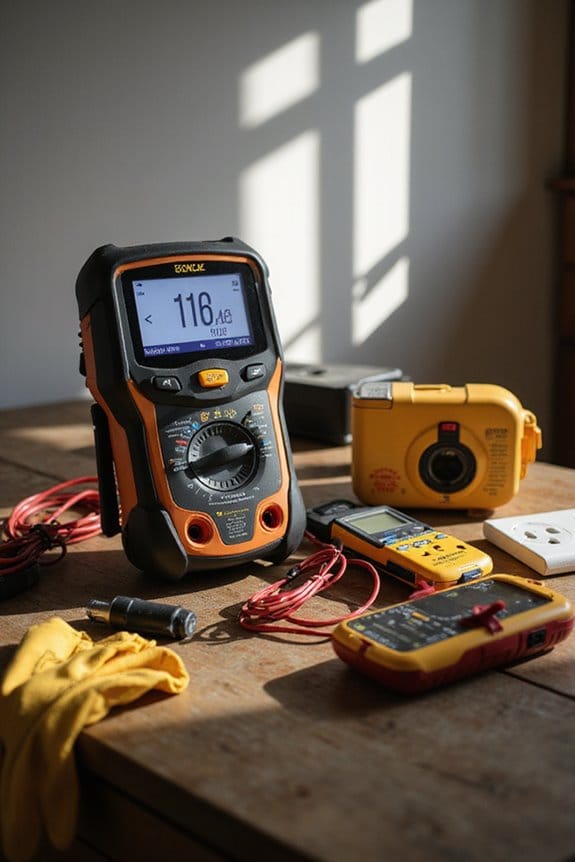
When choosing a GFCI tester, you need to contemplate several important factors. Think about testing functionality and features, build quality, and how easy it is to use—after all, nobody wants a complicated tool when a simple one gets the job done! Safety compliance standards and the voltage range also play a big role, so make sure you pick a tester that fits your needs perfectly.
Testing Functionality and Features
Choosing the right GFCI tester can feel a bit overwhelming, especially with so many options out there. But don’t worry—here are some essential features to take into account:
- Multiple Testing Capabilities: Look for testers that can check ground fault interruption, open ground, and more.
- Clear Visual Indicators: Testers with LED lights are a breeze to read, helping you spot issues quickly.
- Built-in Testing Functionality: This feature lets you confirm GFCI device status with ease.
- Safety Standards Compliance: Verify your tester meets CAT ratings and CE certifications for reliable use.
- Ergonomic Design: Opt for tools that feel good to handle. Trust me, your hands will thank you during those long inspection sessions!
Durability and Build Quality
After ensuring your GFCI tester’s functionality with its various testing capabilities and clear indicators, you’ll want to turn your attention to durability and build quality. Here are some key factors to evaluate:
- Material: Look for testers made with high-impact resistant materials, like polycarbonate or rubber. They’re your best friends against drops!
- Design: An ergonomic shape can boost comfort and keep fatigue at bay during long jobs.
- Product Ratings: High ratings often mean satisfied customers, hinting at longevity.
- Safety Compliance: Make sure it meets safety standards, like OSHA or NRTL, for added reliability.
- Heavy-Duty Use: Features like crush resistance ratings show how it’ll handle tough conditions. Trust me, you’ll appreciate that in the field!
Ease of Use
Everyone appreciates a tool that’s easy to use, especially when dealing with something as critical as electrical safety. When choosing a GFCI tester, keep these factors in mind:
- LED Indicators: Look for clear lights, like green for correct wiring and red for faults. This makes understanding wiring conditions a breeze.
- Simple Design: A plug-and-play setup means you won’t need a manual thicker than a dictionary to get started.
- Immediate Feedback: Real-time voltage readings build your confidence in diagnosing issues effectively.
- One-Touch Testing: Verify GFCI outlets quickly without complicated procedures—who doesn’t like that?
- Compact Size: Ergonomic designs help you navigate tight spaces or during prolonged use without cramping your style!
Safety Compliance Standards
When it comes to selecting a GFCI tester, understanding safety compliance standards is essential for guaranteeing you’re not just buying a fancy tool but a reliable one. Here are three key factors to take into account:
- National Electrical Code (NEC): Verify your tester meets NEC requirements for specific GFCI outlet locations to avoid electrical shock hazards.
- CAT Ratings: Look for options with CAT II ratings for low voltage applications. This guarantees the tester can handle unexpected voltage spikes safely.
- Certifications: Go for testers that are OSHA recognized, UL listed, and CE certified. These marks indicate they’ve passed rigorous safety and performance tests.
Voltage Range and Ratings
Choosing the right GFCI tester isn’t just a matter of picking any tool off the shelf—it’s about finding one that fits your needs. Here are key factors to take into account:
- Voltage Range: Standard testers work between 110-125V AC. If you deal with higher voltages, look for models that handle up to 250V AC.
- CAT Ratings: Higher ratings mean better safety. A CAT III 1000V rating’s ideal for professional environments.
- Trip Range: A tester with a trip range of 6-9 mA is essential for effectively testing GFCI devices.
- Fault Detection: Verify it can spot wiring issues, like open ground or hot/ground reversals, to keep you safe.
Pick wisely; your safety depends on it!
Frequently Asked Questions
How Do I Properly Use a GFCI Tester?
Did you know around 30% of electrical shocks come from faulty outlets? To use a GFCI tester properly, follow these steps:
- Plug it in: Insert the tester into the outlet you want to check.
- Press the button: Hit the test button on the device.
- Check the lights: Observe the indicator lights for correct readings.
If it fails, you’ve got a potential hazard, so deal with it stat! Safety first!
What Are the Common Signs of a Faulty GFCI Outlet?
When you suspect a GFCI outlet’s faulty, look for these signs:
- Frequent Trips: If it trips often, it might be struggling.
- No Reset: If the reset button doesn’t work, that’s a red flag.
- Physical Damage: Cracks or burns? Time to replace it.
- Buzzing Sounds: Odd noises aren’t normal!
If you notice any of these, don’t ignore them. It’s better to be safe than shocked, right?
Can I Use a GFCI Tester on Non-Gfci Outlets?
You can’t use a GFCI tester on non-GFCI outlets. Here’s why:
- Functionality: GFCI testers check ground faults, which non-GFCI outlets don’t monitor.
- Results: You’ll get false readings, leaving you confused.
- Use Proper Tools: For non-GFCI outlets, stick with a standard outlet tester.
How Often Should I Test My GFCI Outlets?
Think of your GFCI outlets as the guardians of your electrical safety. To keep them in top shape, test them at least once a month. Here’s how often you should check:
- Monthly – It’s like a routine check-up for your outlets.
- After storms – Water and electricity don’t mix well!
- If you notice any issues – Better safe than sorry.
Trust me, staying proactive now can save you from big headaches later!
Are GFCI Testers Safe for Outdoor Use?
Yes, GFCI testers can be safe for outdoor use, but there are a few things you should keep in mind:
- Weatherproof Design: Make sure your tester is rated for outdoor conditions. Look for waterproof models.
- Proper Technique: Always use it in a dry area to avoid slips or shocks.
- Follow Guidelines: Stick to the manufacturer’s recommendations for safety.
In short, don’t take chances; safety’s no joke—even outside!



